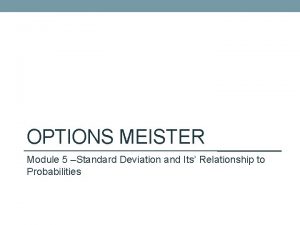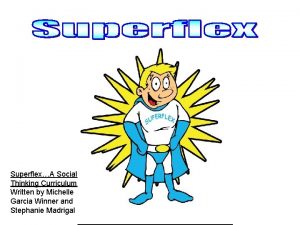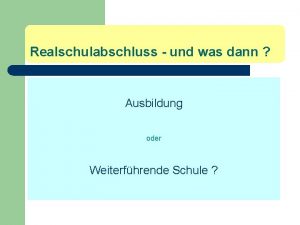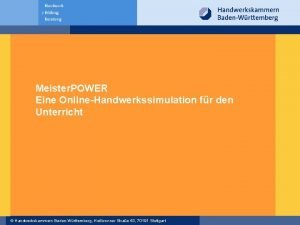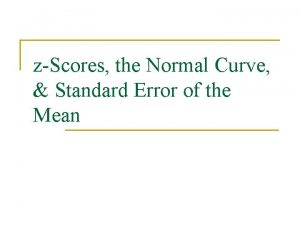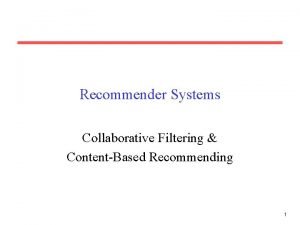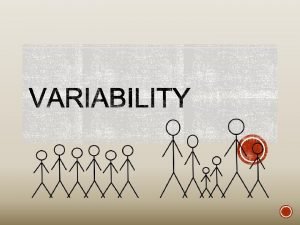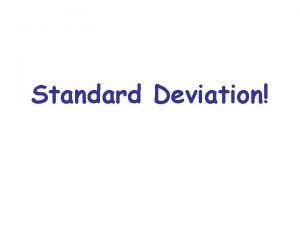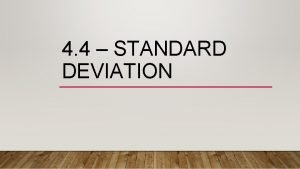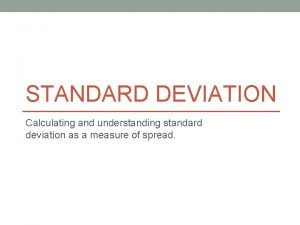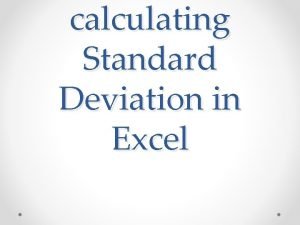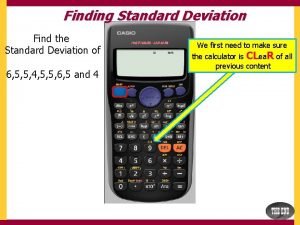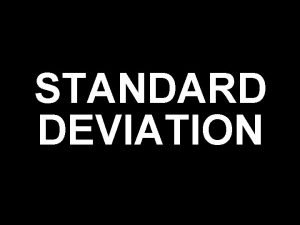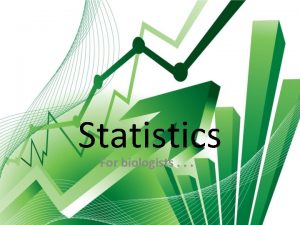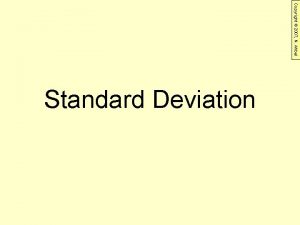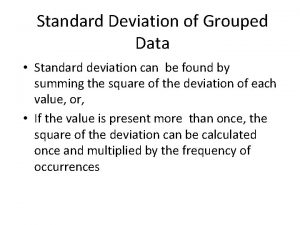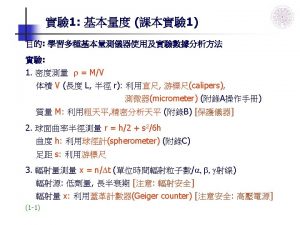OPTIONS MEISTER Module 5 Standard Deviation and Its















- Slides: 15

OPTIONS MEISTER Module 5 –Standard Deviation and Its’ Relationship to Probabilities

Standard Deviation – Basics • As we become more and more committed to Probability Based Trading we find that we can control the Probability of Profit on any trade that we consider. Most traders have no clue that this information exists and how to use it to enhance trading results. • Probability is directly related to implied volatility (IV) through standard deviation (SD) • Standard Deviation is a measure of dispersion from the mean of a sample set of data. The more spread apart the data, the higher the deviation. Standard deviation is calculated as the square root of variance. • 1 SD = Price x (IV x (square root DTE/365)) • In finance, standard deviation is applied to the annual rate of return of an investment to measure the investment's volatility. Standard deviation is also known as historical volatility and is used by investors as a gauge for the amount of expected volatility.

Investopedia explains “Standard Deviation” • Standard deviation is a statistical measurement that sheds light on historical volatility. For example, a volatile stock will have a high standard deviation while the deviation of a stable blue chip stock will be lower. A large dispersion tells us how much the return fund is deviating from the expected normal returns.

Standard Deviation Chart

Standard Deviation – What It Means? • Using the normal distribution a stock will close: • 68. 2% of the time within 1 SD • 34. 1 + 34. 1 = 68. 2 • 95. 4% of the time within 2 SD • 34. 1 +13. 6 + 13. 6 = 95. 4 • 99. 7% of the time within 3 SD • 34. 1 + 13. 6 +2. 15 + 2. 15

Standard Deviations Illustrated

What Does Standard Deviation Predict? • For our purposes the implied volatility (IV) of an option is equal to 1 standard deviation (SD) annual expected move of the underlying. • That means a $100 stock that has an IV of 20% will fall within a range of plus or minus $20. 00. Therefore, the annual expected range is from $80 to $120 68. 2% of the time. • So it is easy to see how, given the right technology, we can use this in our trading to predict the potential range.

Understanding 1 SD • It is confusing to many how a 84% probability OTM on both the call and put side somehow is a 1 SD move of 68. 2% • Here is how you correlate a 1 SD move 68. 2% to a 84% probability OTM. • You want to sell a 1 SD strangle that has a 68. 2% probability of expiring OTM. You sell the 84% OTM Call (16%ITM) and you sell the 84% OTM Put (16%ITM) • So 16% on the Call Side and 16% on the Put Side = a total of 32% • Subtract 100% - 32% = 68% • If you refer to the chart (slide 6) and add everything to the right of the 1 SD mark: 13. 6%+2. 1%+0. 1% = 15. 8% (or approximately 16%). (Same for the left side) • Therefore, the probability of a 1 SD short call closing ITM is 16% and the same 16% ITM is true on the put side

Understanding 1 SD (continued) • 16% Call Side & 16% Put side each has an 84% probability OTM • This is how to correlate the 1 SD move with an 84% probability of finishing OTM • This explains how the 68. 2% and 84% are related • Armed with this information we will now see how we can use it on time frames other than 1 year.

Implementing SD • The implied volatility of an option is equal to 1 SD annual expected move of the underlying. • This is great for trades lasting one year, our trades focus on timeframes of 20 to 45 DTE. How can we use IV to calculate the expected moves in these shorter timeframes? • Here is the formula: • % Expected Move = Price x (IV * (sqrt(365/DTE)))

Consider This Information • Many challenge the use of probabilities to forecast expected moves and to put the odds in your favor. The question becomes “if probability trading is accurate, logic would dictate that it is a zero sum game”? Additionally, why do real world results not precisely equal the calculated probabilities? • Research has proven that IV is overstated. This is the market makers edge. So if IV is overstated, then premiums are higher than what the probabilities. The edge goes to the house! • Just like casinos and insurance companies • Options are a derivative product. IV is the primary and most significant variable in the formula. IV is derived from the price of options. When applied to the underlying instruments we trade that are highly liquid the options market is extremely efficient.

What You Need to Know • While selling options has higher probability of profit (POP) shorting does carry more risk than buying options. For this reason, sellers will typically demand more premium for this additional risk. • The higher prices demanded by the sellers cause the probabilities to exaggerate predicted movement and thus refute the argument that it is a zero sum game. • As your sample size grows (more and more trades) you will discover that the actual performance for short premium trades do better than the probabilities forecast.

Focus on IV • In light of the fact that probabilities are based on IV and IV constantly changes and reverts to the mean the trader will conclude that the probabilities are snapshot of the moment using current IV. If IV moves higher after you enter the trade then the short premium probabilities get worse. Conversely, if IV moves lower (IV crush) our probabilities go up. • Our method focuses on IV and primarily selling high IV and looking for the reversion to the mean. • Any directional trade has a 50/50 probability when placed. Using PBT we can be 100% wrong on direction and still have winning trades due to our knowledge and execution trades and the IV

More IV Facts • After executing the trade we do not evaluate the probabilities. Our trade decision is made at execution and even if we are wrong on direction we have a high probability of success due to mean reversion. It is all about IV!! • IV is the variable we use to build most of our trades. IV gives an anticipated move of the underlying instrument within an acceptable degree of accuracy. • It is important to remember that IV and the resulting SD are not a “holy grail”. There can still be outlier moves. That is why we trade small size and a large number of trades to make the probabilities work in our favor.

Standard Deviation Calculator • Enter Data in Yellow Shaded Fields Only • Double Click Calculator to Activate • Enter Underlying Current Price>>>>>>>>> • Enter Implied Volatility >>>>>>>>>>>> • Enter Days Until Expiration >>>>>>>>>> • Result for 1 Standard Deviation Move >>>>>> • Result for 2 Standard Deviation Move >>>>>>
 Standard deviation options
Standard deviation options Mean absolute deviation steps
Mean absolute deviation steps Formula for standard error
Formula for standard error Was funny once superflex
Was funny once superflex Meister gleich fachhochschulreife
Meister gleich fachhochschulreife Meisterpower
Meisterpower Bulgakovi tegelane
Bulgakovi tegelane Tajufoneetika
Tajufoneetika Meister cycle
Meister cycle Zinaida kiisk
Zinaida kiisk M bulgakov
M bulgakov Ventaja en costes
Ventaja en costes Error
Error Variance standard deviation formula
Variance standard deviation formula Covariance and standard deviation
Covariance and standard deviation Range variance and standard deviation
Range variance and standard deviation
